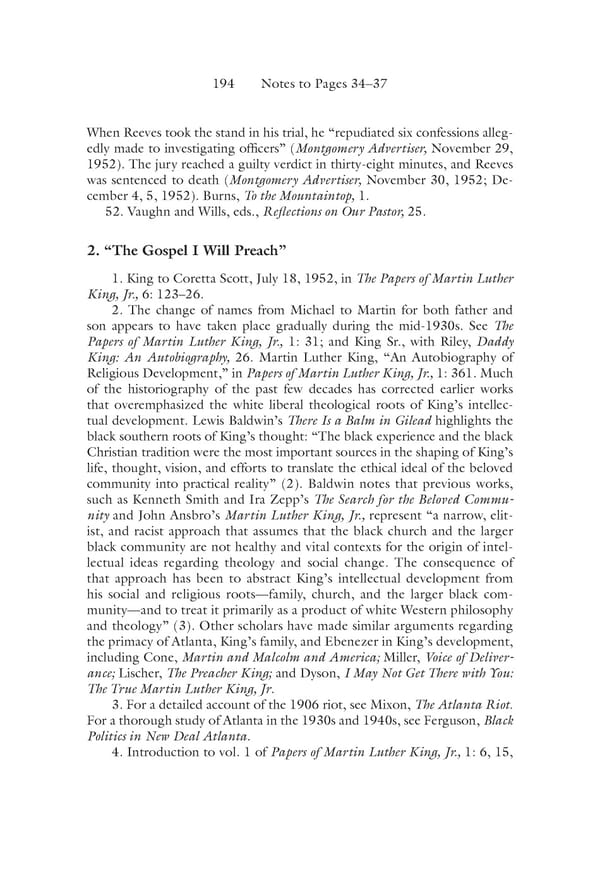194 Notes to Pages 34–37 When Reeves took the stand in his trial, he “repudiated six confessions alleg- edly made to investigating officers” (Montgomery Advertiser, November 29, 1952). The jury reached a guilty verdict in thirty-eight minutes, and Reeves was sentenced to death (Montgomery Advertiser, November 30, 1952; De- cember 4, 5, 1952). Burns, To the Mountaintop, 1. 52. Vaughn and Wills, eds., Reflections on Our Pastor, 25. 2. “The Gospel I Will Preach” 1. King to Coretta Scott, July 18, 1952, in The Papers of Martin Luther King, Jr., 6: 123–26. 2. The change of names from Michael to Martin for both father and son appears to have taken place gradually during the mid-1930s. See The Papers of Martin Luther King, Jr., 1: 31; and King Sr., with Riley, Daddy King: An Autobiography, 26. Martin Luther King, “An Autobiography of Religious Development,” in Papers of Martin Luther King, Jr., 1: 361. Much of the historiography of the past few decades has corrected earlier works that overemphasized the white liberal theological roots of King’s intellec- tual development. Lewis Baldwin’s There Is a Balm in Gilead highlights the black southern roots of King’s thought: “The black experience and the black Christian tradition were the most important sources in the shaping of King’s life, thought, vision, and efforts to translate the ethical ideal of the beloved community into practical reality” (2). Baldwin notes that previous works, such as Kenneth Smith and Ira Zepp’s The Search for the Beloved Commu- nity and John Ansbro’s Martin Luther King, Jr., represent “a narrow, elit- ist, and racist approach that assumes that the black church and the larger black community are not healthy and vital contexts for the origin of intel- lectual ideas regarding theology and social change. The consequence of that approach has been to abstract King’s intellectual development from his social and religious roots—family, church, and the larger black com- munity—and to treat it primarily as a product of white Western philosophy and theology” (3). Other scholars have made similar arguments regarding the primacy of Atlanta, King’s family, and Ebenezer in King’s development, including Cone, Martin and Malcolm and America; Miller, Voice of Deliver- ance; Lischer, The Preacher King; and Dyson, I May Not Get There with You: The True Martin Luther King, Jr. 3. For a detailed account of the 1906 riot, see Mixon, The Atlanta Riot. For a thorough study of Atlanta in the 1930s and 1940s, see Ferguson, Black Politics in New Deal Atlanta. 4. Introduction to vol. 1 of Papers of Martin Luther King, Jr., 1: 6, 15,
 Becoming King: Martin Luther King Jr. Page 214 Page 216
Becoming King: Martin Luther King Jr. Page 214 Page 216